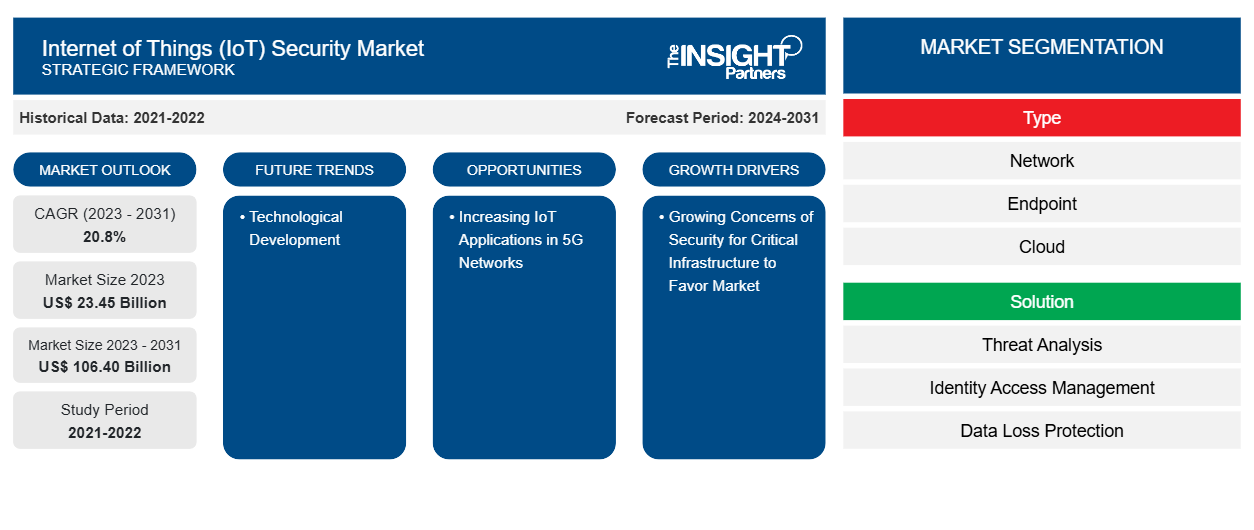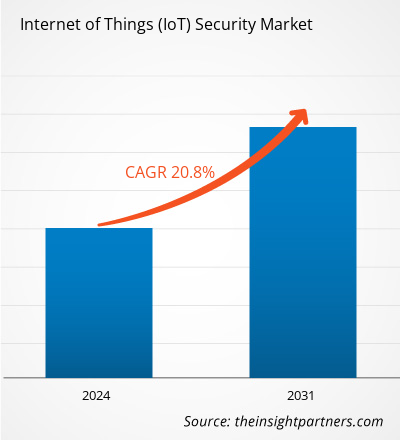The Internet of Things (IoT) Security market is expected to reach US$ 106.4 billion by 2031 from US$ 28.3 billion in 2024; it is expected to record a CAGR of 20.8% during the forecast period. Growing concerns about security for critical infrastructure and the growth of smart cities are fueling the IoT security market growth.
Internet of Things (IoT) Security Market Analysis
Several key factors drive the Internet of Things (IoT) Security market. A number of factors are driving this growth. One of them is an increase in Industry 4.0 IOT security incidents that highlight the need for increased cyber resilience. These IOT vulnerabilities give hackers new avenues to exploit, an increase in IOT security regulations, and an increase in security concerns for critical infrastructure.
Internet of Things (IoT) Security Market Overview
Securing IoT devices and networks against data theft and data distortion by hackers is known as IoT (Internet of Things) security. The need to protect the future of internet-connected devices by robustly installing necessary/next-generation security measures, enhancing transparency, and granting users the option to deny data gathering is one of the key reasons driving the market over the projection period.
Customize This Report To Suit Your Requirement
You will get customization on any report - free of charge - including parts of this report, or country-level analysis, Excel Data pack, as well as avail great offers and discounts for start-ups & universities
Internet of Things (IoT) Security Market: Strategic Insights

-
Get Top Key Market Trends of this report.This FREE sample will include data analysis, ranging from market trends to estimates and forecasts.
Internet of Things (IoT) Security Market Drivers and Opportunities
Growing Concerns of Security for Critical Infrastructure to Favor Market
Hackers are concentrating on Internet of Things (IoT) devices and taking advantage of well-known flaws like passwords, default usernames, and static code backdoors. All industries are embracing automation in the modern world through IOT integration. Early adopters of the Internet of Things, essential infrastructures like water, power, and other resources are currently automating.
Automation increases operating efficiency significantly, but it also leaves systems vulnerable to cyberattacks. Growing systemic vulnerability has emerged as the world's top concern for governments. A nuclear reactor's controls represent a serious risk to both human life and property in the event that they are intentionally or maliciously tampered with.
Increasing IoT Applications in 5G Networks
Multi-access Edge Computing (MEC) and 5G's low latency assist in optimizing output in a loT-enabled smart factory. The ICT sector is adopting IOT services and applications more quickly because of 5G technology. In large-scale distant locations like mines and connected vehicles, 5G is anticipated to open up new use cases in remote monitoring, visual inspection, and autonomous operations.
Internet of Things (IoT) Security Market Report Segmentation Analysis
Key segments that contributed to the derivation of the Internet of Things (IoT) Security market analysis are type, solution, and application.
- Based on type, the Internet of Things (IoT) security market is divided into network, endpoint, cloud, application security, and others. The cloud segment is anticipated to grow in the forecast period.
- By solution, the market is segmented into threat analysis, identity access management, data loss protection, encryption, dispatch & incident response, distributed denial of service protection, and others. The identity access management segment is anticipated to grow in the forecast period.
- Based on application, the Internet of Things (IoT) security market is divided into smart homes, connected cars, information & communication technology, smart factories, BFSI, smart retail, smart healthcare, smart transportation, wearable, and others. The information and communication technologies segment is anticipated to grow in the forecast period.
Internet of Things (IoT) Security Market Share Analysis by Geography
The geographic scope of the Internet of Things (IoT) security market report is mainly divided into five regions: North America, Asia Pacific, Europe, Middle East & Africa, and South America/South & Central America. North America has dominated the Internet of Things (IoT) security market. High technology adoption trends in various industries in the North American region have fuelled the growth of the Internet of Things (IoT) security market. Factors such as increased adoption of digital tools and high technological spending by government agencies are expected to drive the North American Internet of Things (IoT) security market growth. Moreover, a strong emphasis on research and development in the developed economies of the US and Canada is forcing the North American players to bring technologically advanced solutions into the market. In addition, the US has many Internet of Things (IoT) security market players who have been increasingly focusing on developing innovative solutions. All these factors contribute to the region's growth of the Internet of Things (IoT) security market.
Internet of Things (IoT) Security Market Regional Insights
The regional trends and factors influencing the Internet of Things (IoT) Security Market throughout the forecast period have been thoroughly explained by the analysts at The Insight Partners. This section also discusses Internet of Things (IoT) Security Market segments and geography across North America, Europe, Asia Pacific, Middle East and Africa, and South and Central America.
Internet of Things (IoT) Security Market Report Scope
| Report Attribute | Details |
|---|---|
| Market size in 2024 | US$ 28.3 Billion |
| Market Size by 2031 | US$ 106.4 Billion |
| Global CAGR (2025 - 2031) | 20.8% |
| Historical Data | 2021-2023 |
| Forecast period | 2025-2031 |
| Segments Covered |
By Type
|
| Regions and Countries Covered |
North America
|
| Market leaders and key company profiles |
|
Internet of Things (IoT) Security Market Players Density: Understanding Its Impact on Business Dynamics
The Internet of Things (IoT) Security Market is growing rapidly, driven by increasing end-user demand due to factors such as evolving consumer preferences, technological advancements, and greater awareness of the product's benefits. As demand rises, businesses are expanding their offerings, innovating to meet consumer needs, and capitalizing on emerging trends, which further fuels market growth.

- Get the Internet of Things (IoT) Security Market top key players overview
Internet of Things (IoT) Security Market News and Recent Developments
The Internet of Things (IoT) Security market is evaluated by gathering qualitative and quantitative data post primary and secondary research, which includes important corporate publications, association data, and databases. The following is a list of developments in the market:
- In March 2024, - Nozomi Networks Inc., the leader in OT and IoT security, announced it extended its partnership with Yokogawa Electric Corporation to address global demand for managed security services and solutions designed to holistically satisfy the unique OT and IoT cybersecurity requirements of process manufacturers. Yokogawa will offer Nozomi Networks' advanced solutions for OT and IoT visibility, network monitoring, and threat detection to customers worldwide as part of Yokogawa's OpreX Managed Services. Yokogawa will also resell standalone solutions from Nozomi Networks to customers who manage their security programs in-house.
(Source: Nozomi Networks Inc, Press Release, 2024)
Internet of Things (IoT) Security Market Report Coverage and Deliverables
The " Internet of Things (IoT) Security Market Size and Forecast (2021–2031)" report provides a detailed analysis of the market covering below areas:
- Market size and forecast at global, regional, and country levels for all the key market segments covered under the scope.
- Market dynamics such as drivers, restraints, and key opportunities
- Key future trends
- Detailed PEST/Porter's Five Forces and SWOT analysis
- Global and regional market analysis covering key market trends, major players, regulations, and recent market developments.
- Industry landscape and competition analysis covering market concentration, heat map analysis, prominent players, and recent developments.
- Detailed company profiles
Frequently Asked Questions
What is the estimated market size for the global Internet of Things (IoT) Security market in 2023?
What is the driving factor impacting the global Internet of Things (IoT) security market?
What are the opportunities of the global Internet of Things (IoT) security market?
What will be the market size for the global Internet of Things (IoT) security market by 2031?
Which are the key players holding the major market share of the Internet of Things (IoT) security market?
- Historical Analysis (2 Years), Base Year, Forecast (7 Years) with CAGR
- PEST and SWOT Analysis
- Market Size Value / Volume - Global, Regional, Country
- Industry and Competitive Landscape
- Excel Dataset
Recent Reports
Testimonials
Reason to Buy
- Informed Decision-Making
- Understanding Market Dynamics
- Competitive Analysis
- Identifying Emerging Markets
- Customer Insights
- Market Forecasts
- Risk Mitigation
- Boosting Operational Efficiency
- Strategic Planning
- Investment Justification
- Tracking Industry Innovations
- Aligning with Regulatory Trends





















 Get Free Sample For
Get Free Sample For